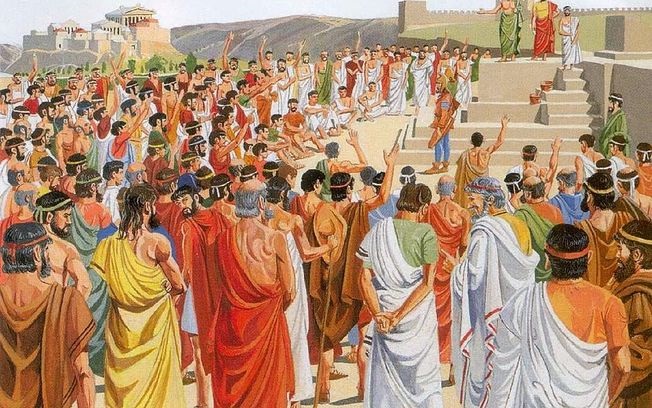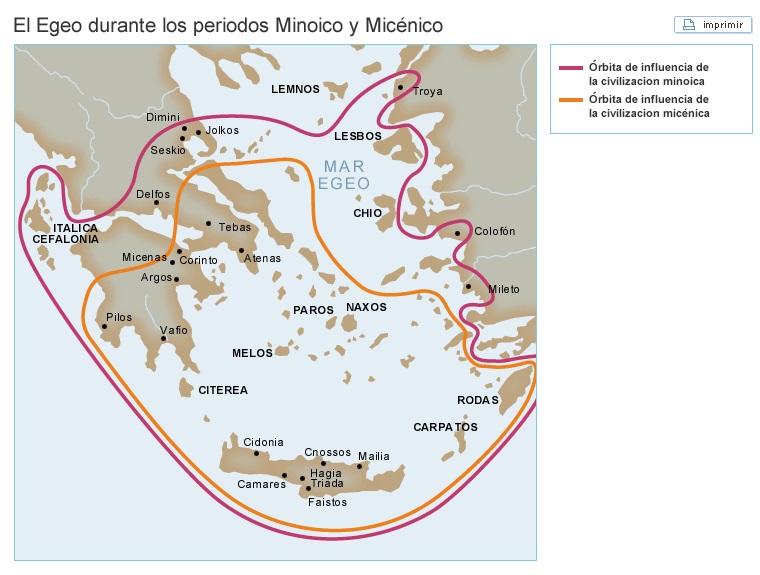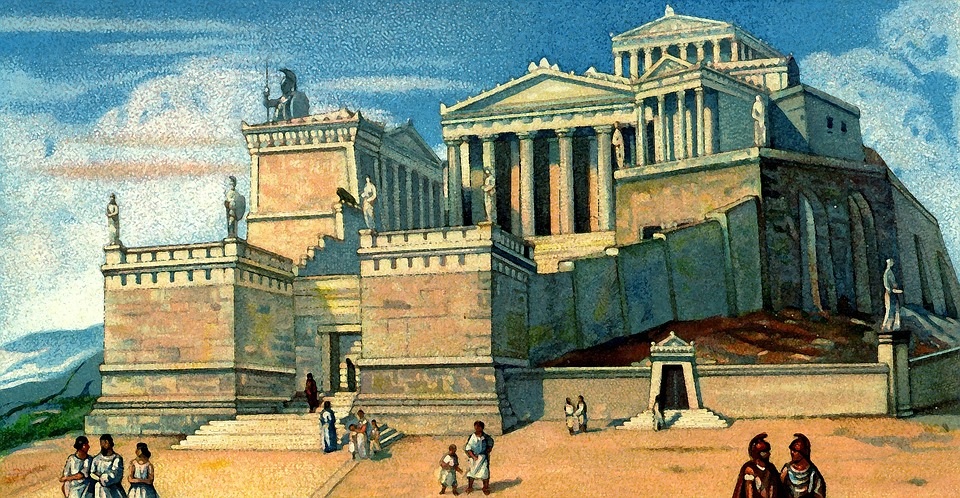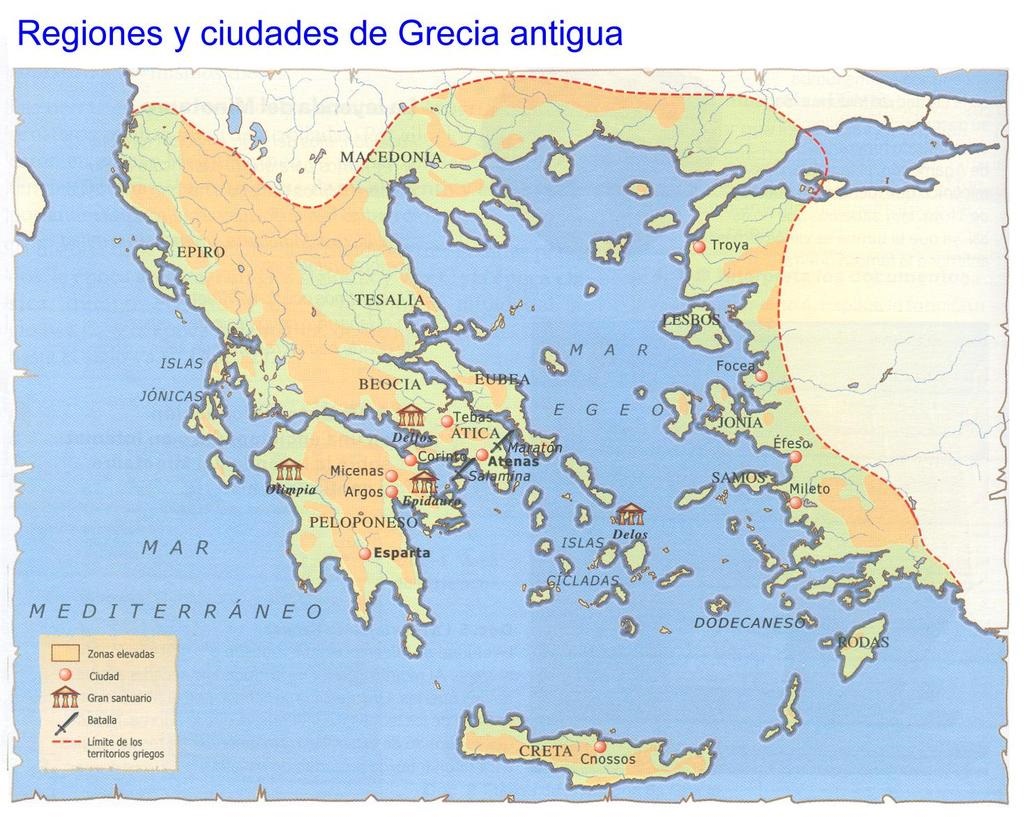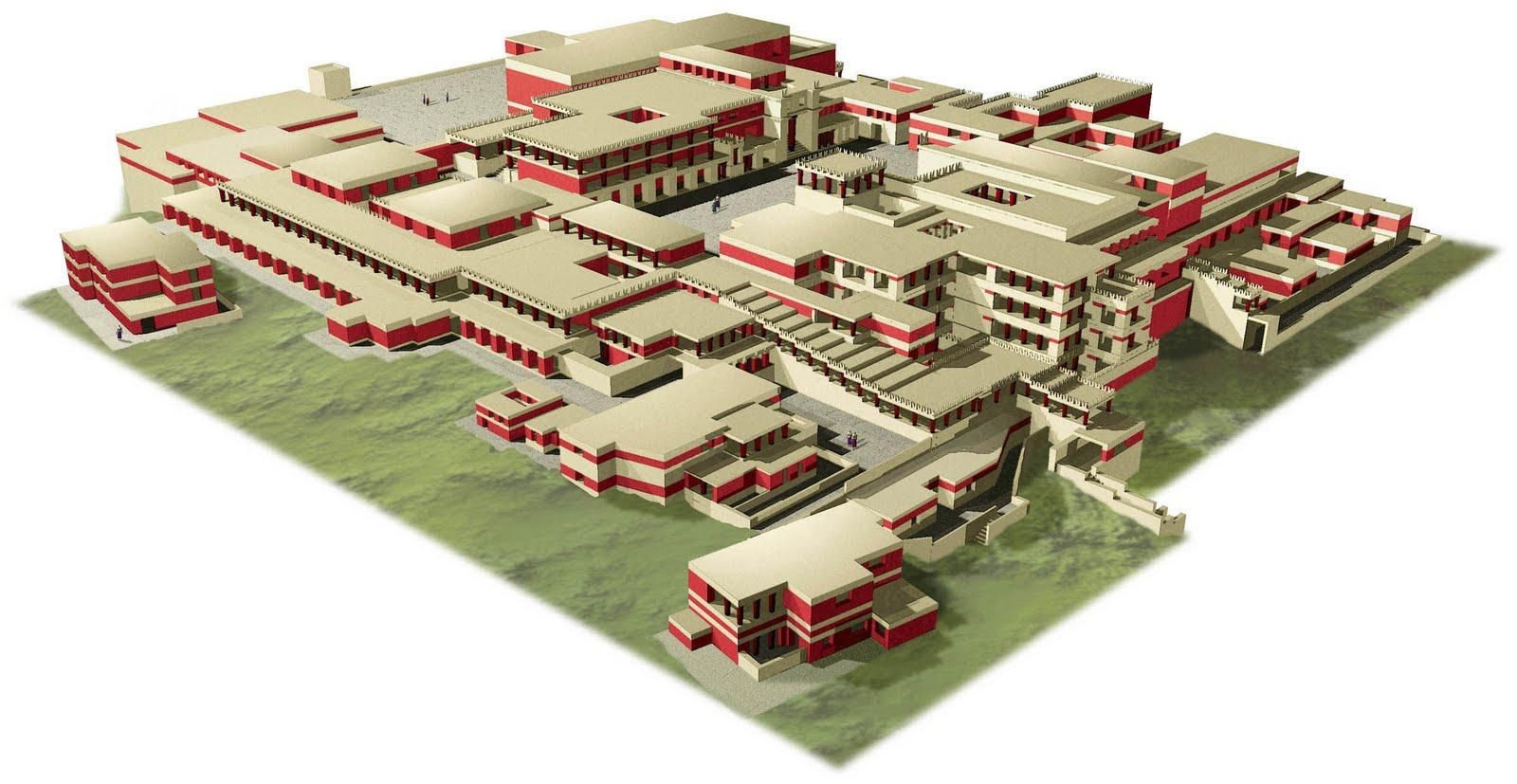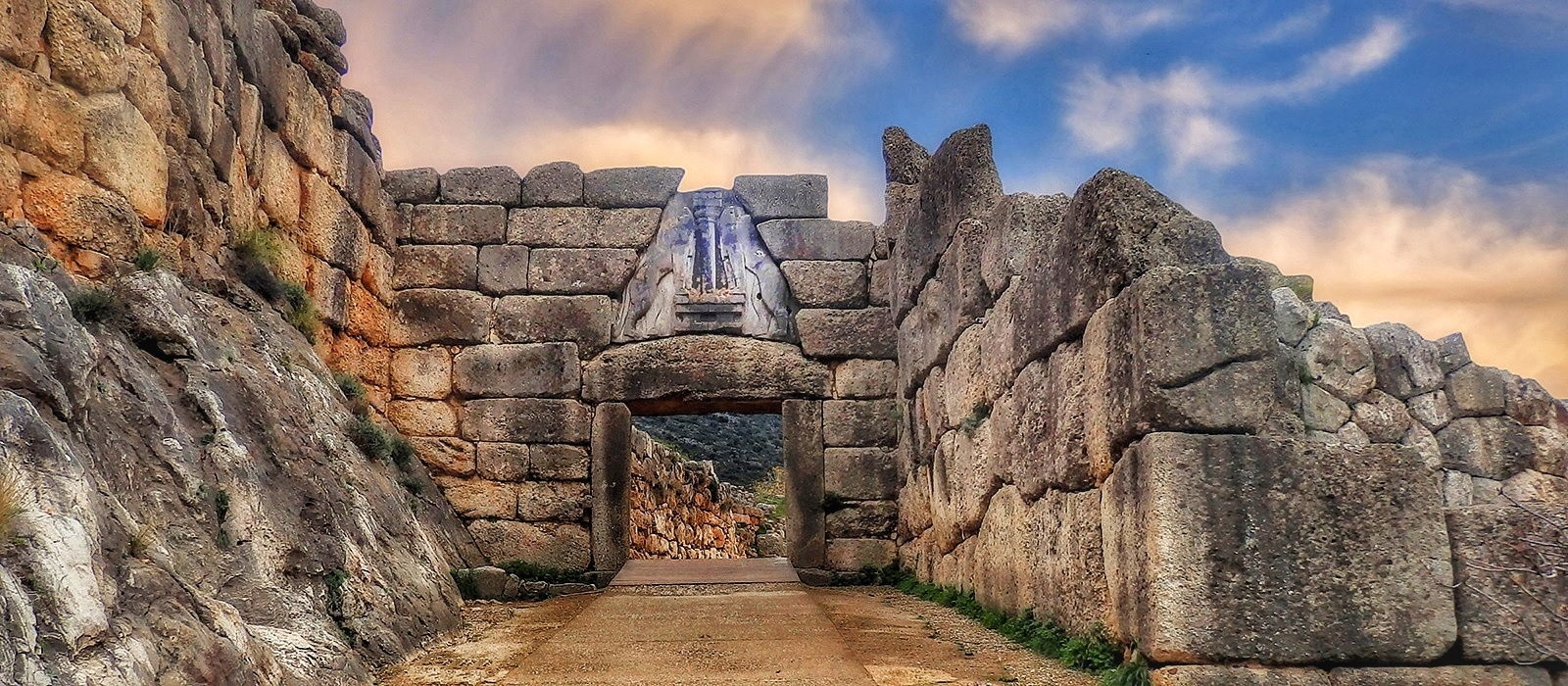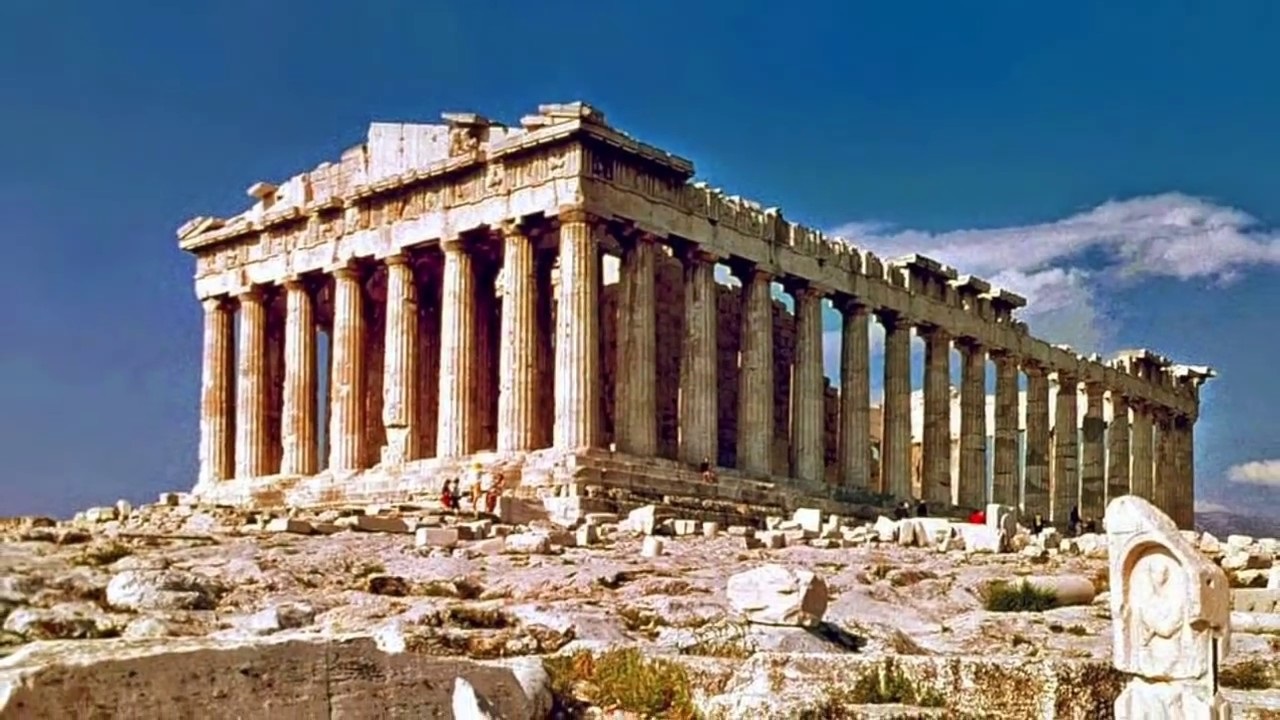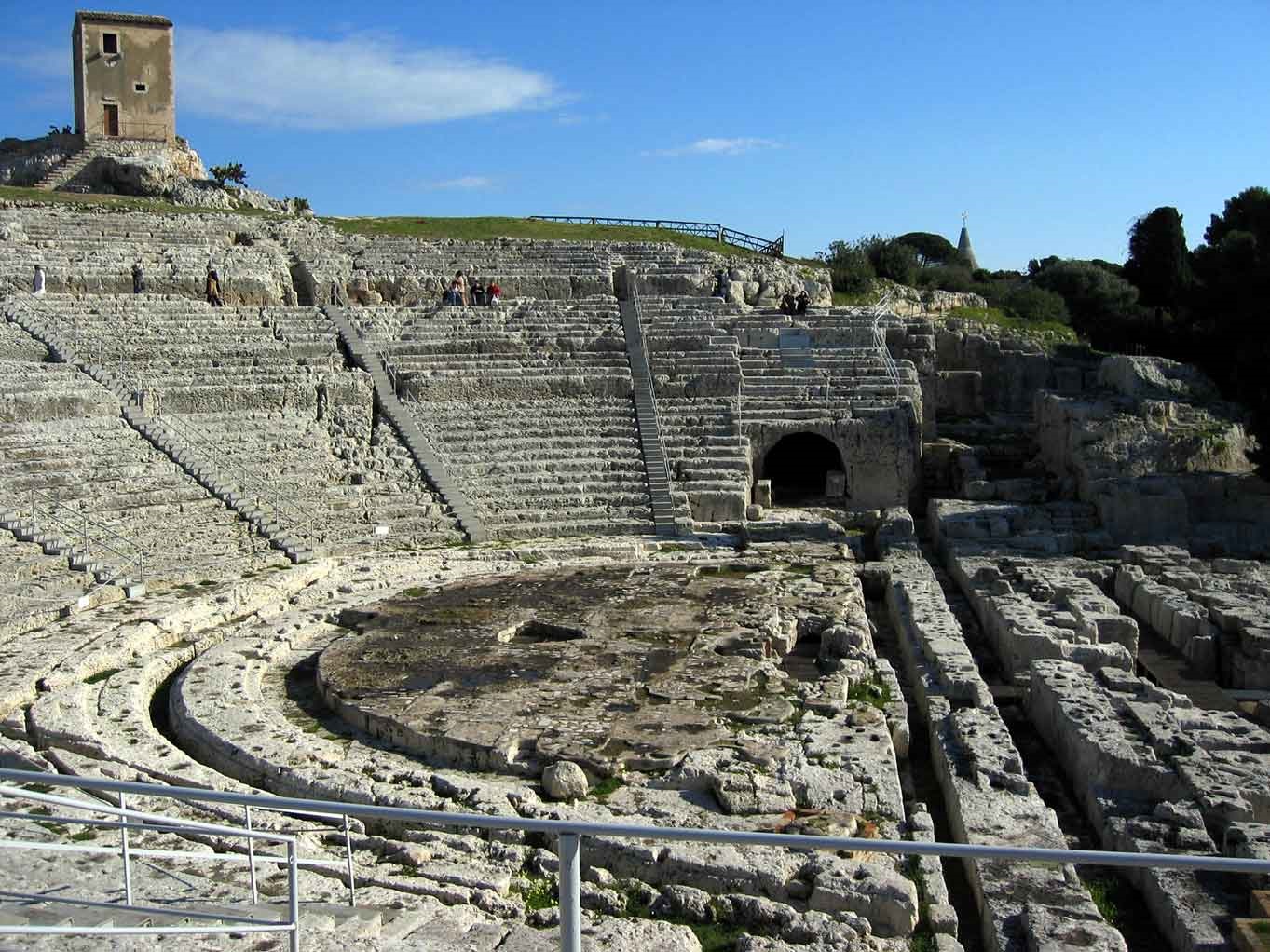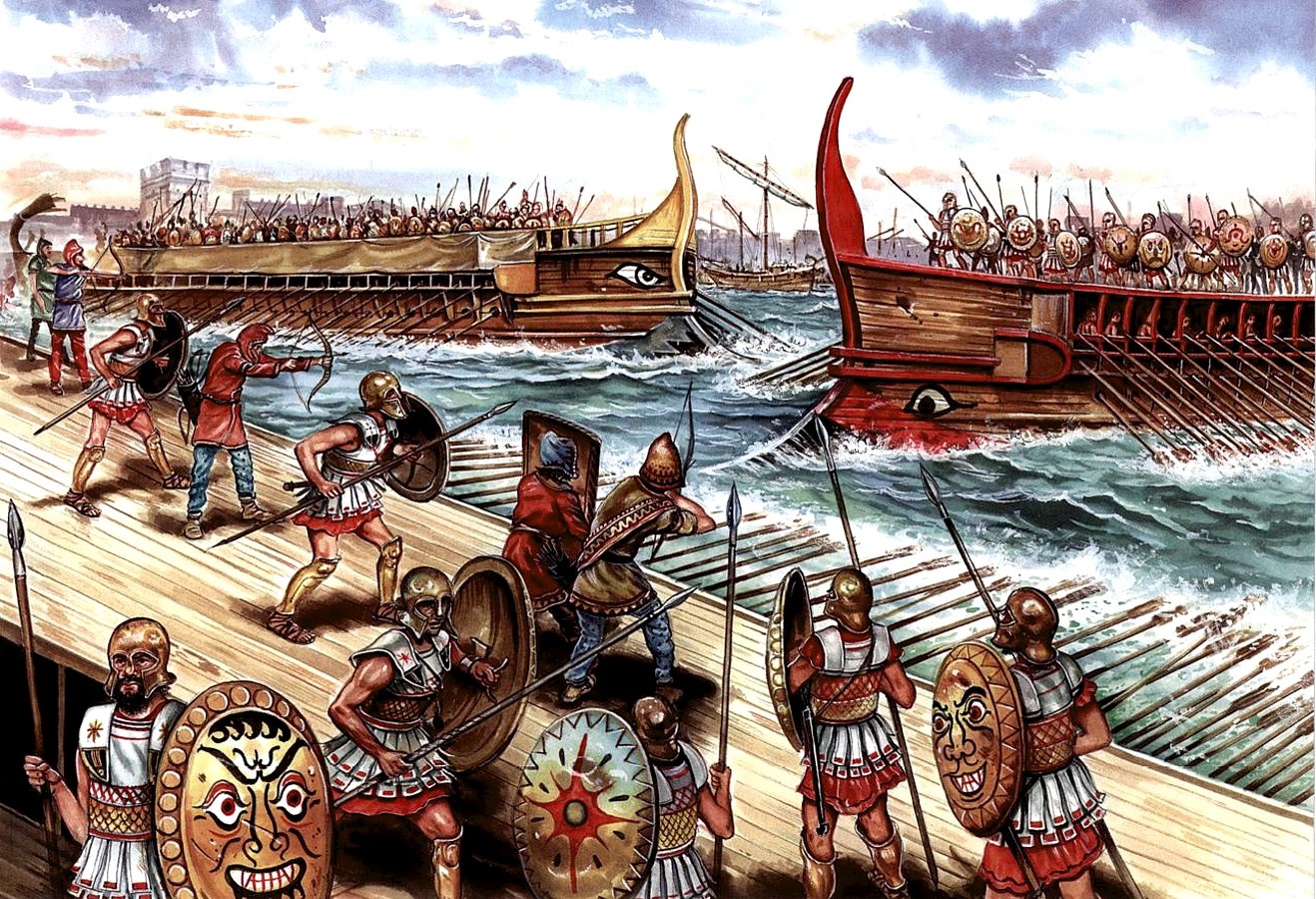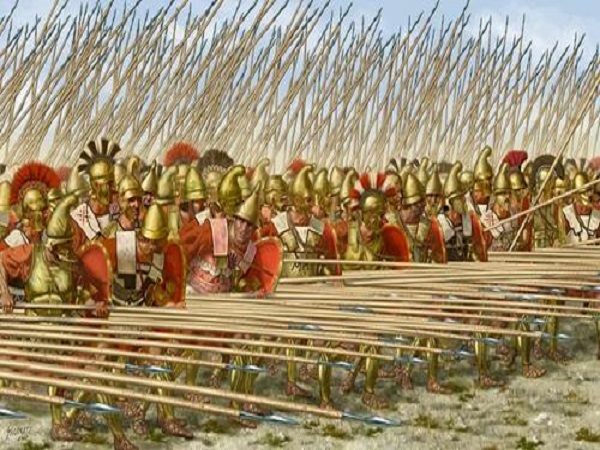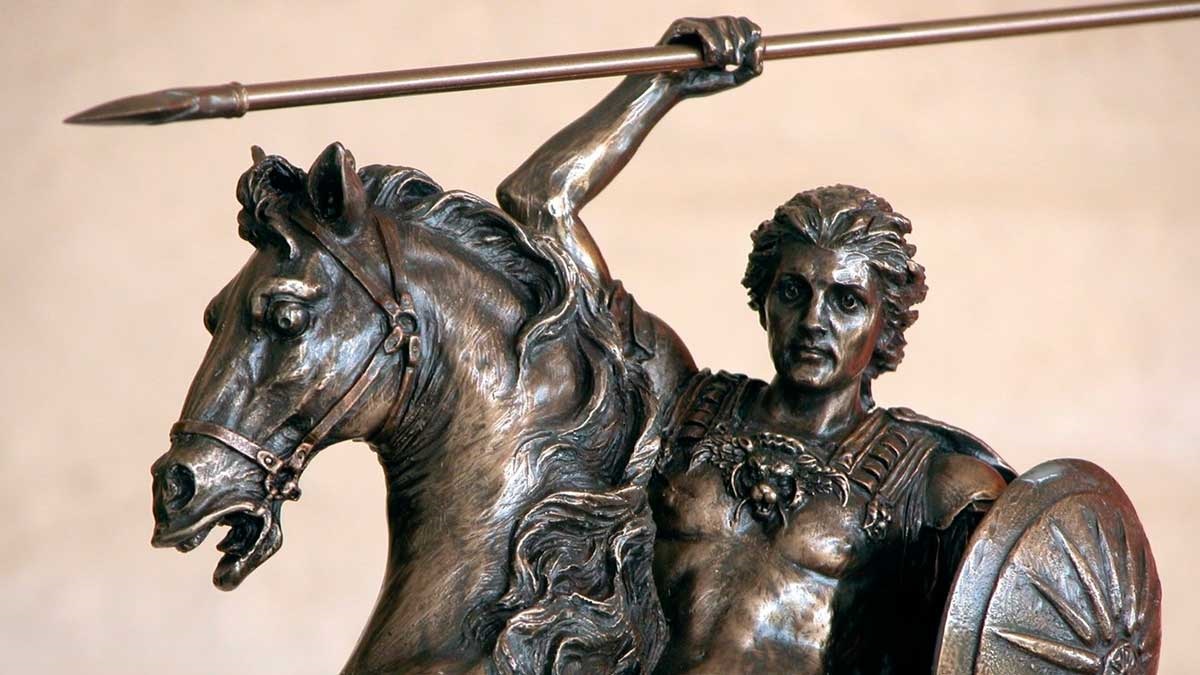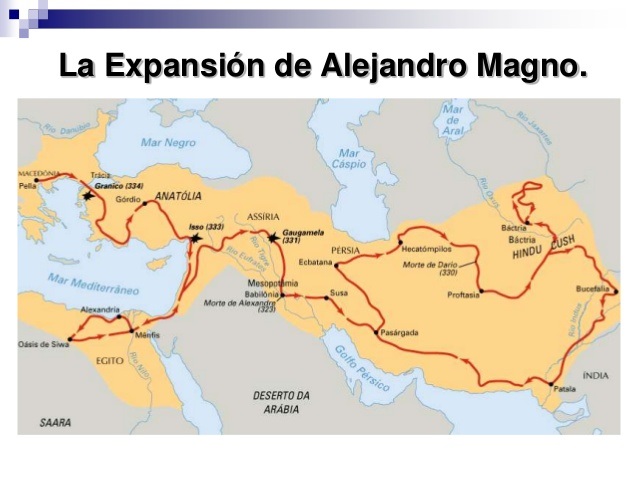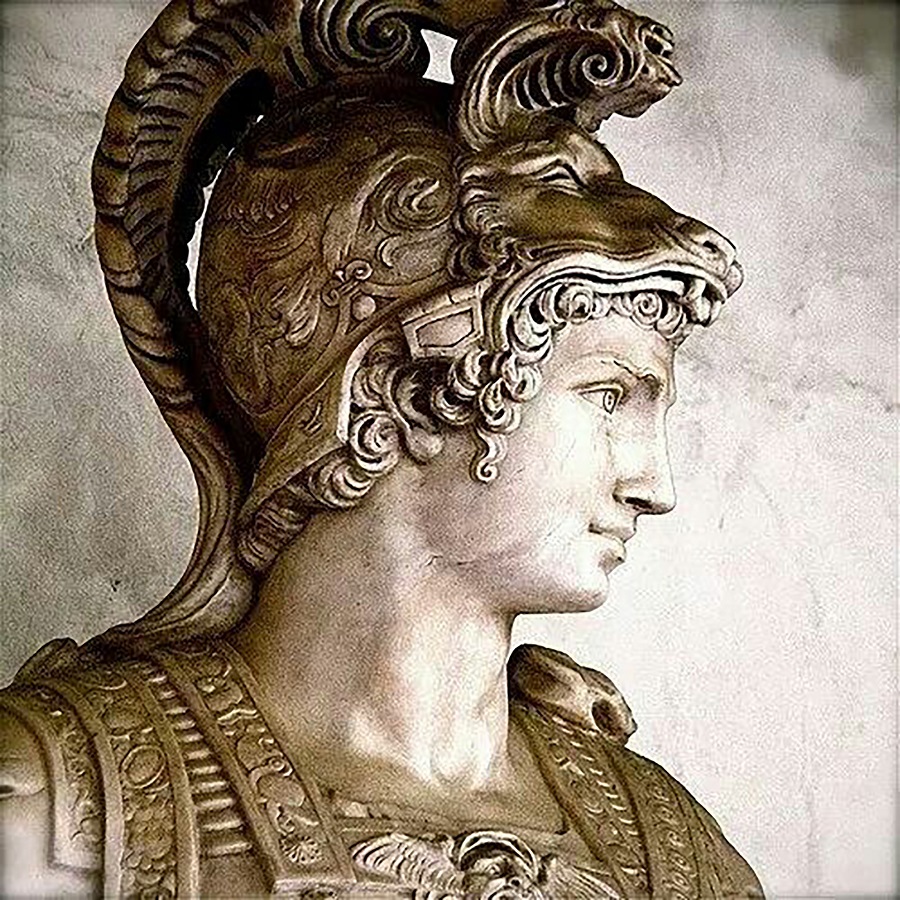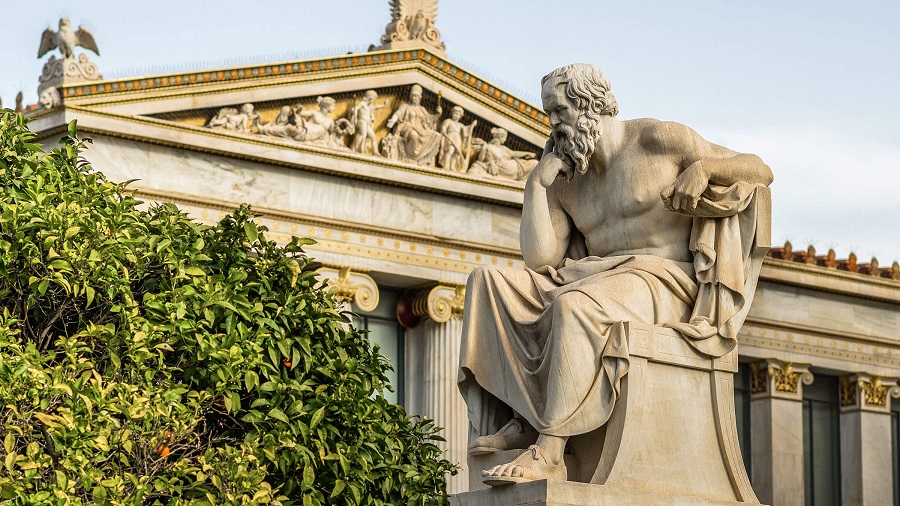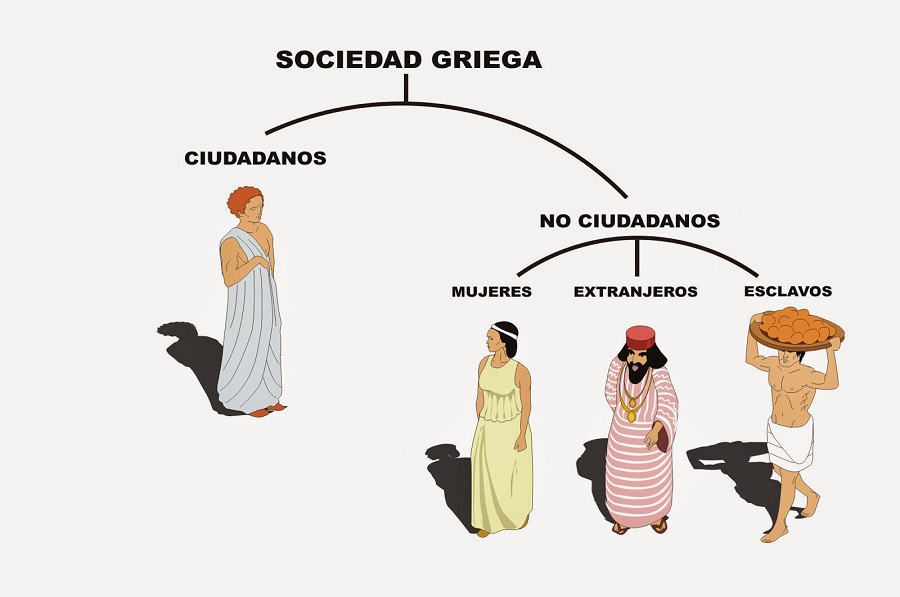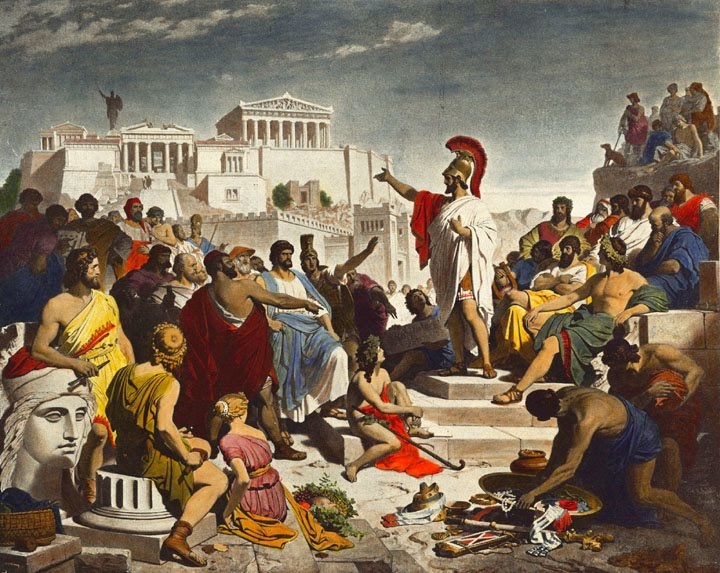To learn a little better about the social organization of Greece, in ancient times, visit this interesting article. Don't stop reading it! and we will also talk about their political organization. Here you will learn the most important on this topic.
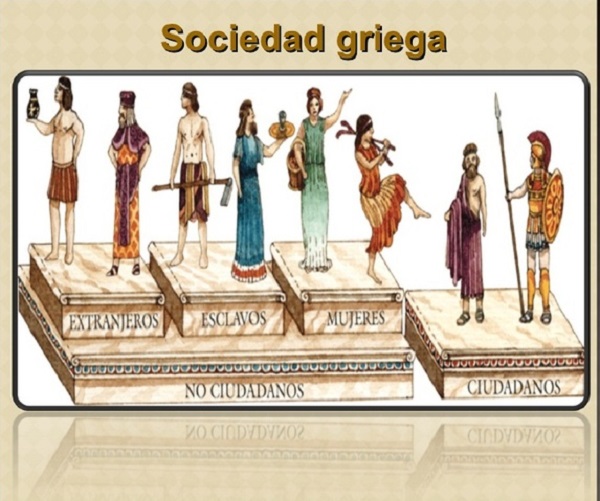
Social organization of Greece
Greece is the cradle of European culture. There, more than three thousand years ago, the foundations of Western culture were born. It is the result of the combination, in the Aegean Sea, around the year 1200 a. C., of all the splendor of oriental antiquity and his encounter with an Indo-European people who emigrated around the year 2000 a. C., whose language was the one given his identity and the basis of his genius.
But this Greek language required the linguistic skills of the Phoenicians, who transformed the sounds of the language into signs. Since then, Greek has been the seed of European civilization, which still permeates everyday life today.
It must be said that the Greeks never called themselves "Greeks", since "graeci" was the nickname by which the Romans called them. In "The Iliad", the oldest work written in Greek, they are called Achaeans. Troy and his famous wooden horse are easy to remember.
This long siege of a walled city probably took place around the XNUMXth century BC. C., in the far west of Asia Minor, but more than four centuries must have elapsed before this text was founded in Greek Literature.
They called themselves "Hellenes", and continue to do so today, because they had a clear consciousness of their identity since ancient times, despite the fact that the classical Greek world never constituted any kind of political unit Herodotus himself said: "We are of the same race and the same language, the altars and the rites of our gods are common, similar in our customs…”. Well, not only language brought them together.
The deep Greek originality lay in the variety of its political, economic and social institutions, which quickly distinguished this city from all those who lived with it in the eastern Mediterranean. The Greeks called "barbarians" everything that was not Hellenic.
Proud of their destiny, the Greeks were aware of this originality and, by the epithet "barbarian", they meant not only that what they were referring to was not Greek, but also that they did not participate in it. citizen soul that encouraged the Hellenes.
Because Greek is perhaps the first truly urban culture of antiquity. The "polis", the supreme acquisition of its culture, shaped the lives of citizens, and also its derivative: "politics".
In five hundred years, this cultural corpus has determined the concerns and desires of the entire European and Western heritage. To understand it, we must go back to its Cretomycenic origins, the life of its city-states and the adventures of its internal conflicts and with other peoples.
Archaic Greece was a land populated by warrior and seafaring peoples. An original civilization arose on the island of Crete about eight thousand years ago, extending its hegemony to the shores of the Aegean Sea. The primitive population of Neolithic populations dates from this period.
But the great leap occurred around 3000 BC. C., as revealed by some domestic and military objects made of good quality bronze. It is easy to deduce that if there was no tin on the island, it came from somewhere else.
Already at that time, and with greater impetus towards the second millennium BC, in these labyrinthine stone constructions, it is possible that it will centralize all community life.
This is evident when looking at the remains preserved at Phaistos, Mallia, Hagia, Triada and Knossos, the most important cities on the island. In addition to the luxurious rooms, cereals and other food stores are seen there.
History
In full bloom of the Cretan culture, called “Minoan”, after Minos, the legendary monarch of Knossos, a new pretender appeared at this stage in the Aegean Sea around 1500 BC. It was the Achaeans who built the cities and palaces of Mycenae, Pylos, Tiryns and the buildings of Sparta.
It seems that these peoples, called Mycenaeans, began around 1300 BC. C. its expansion in the region, and inevitably hit the Cretans.
If these were not mastered earlier, it was due to their robust fleet, but their fateful fate was inexorably fulfilled two centuries later, when an apocalyptic volcanic eruption affected their palates, generating tremors and tremors. catastrophes, which undermined their resistance.
The Achaeans had already written their name in history a hundred and a half years ago, when they besieged and destroyed Troy. So they built a great coalition of cities in the Aegean Sea, including Crete. After a decade of fighting, the city with monumental walls prevailed with a ruse.
Since then, Mycenae and its king Agamemnon have established their rule over this corner of the world. But their empire was not eternal, and the Mycenaean kingdoms were replaced by a new invasion, the Dorians, from which, after a long time, the Greek city was born.
While cities already existed in Crete and the Peloponnese, as well as older ones in Egypt or Mesopotamia, there was one difference between these eastern metropolises and the nascent polis: the single Greek communal body.
To begin with, these Eastern cities could not qualify as a city. Conglomerates of palaces, temples, and official quarters housed only within the monarch's family, his favourites, officials, and servants.
Those who built with their hands the wealth of the powerful and the glory of their kings did not live there. The peasants of these societies lived in the fields.
The countryside and the city
It seems that the Greeks practiced specialized agriculture, on very steep and broken land, not very conducive to multi-regional grouping. This has encouraged disengagement from its urban crowds.
The Greek of the time found the city a place of social life and the relative proximity of the fields made it easy for the peasant to become a city dweller. Of course, such a state could not be maintained forever as the population increased and the fields became more and more distant.
But it happens that, in a territory like Greece, full of obstacles to the extension of the cereal economy, the most productive, the conflict resulting from population growth has been resolved by emigration.
Adventurers and those with difficult access to land came together in an expedition that founded a new city on another part of the coast. Thus, many of the most peculiar and archaic cultural bases of the polis extended to the Black Sea.
Birth of the Polis
This Greek-speaking people, the Dorians, like a land-thirsty prey, ran around 1200 B.C. C. in the old scene hegemonized by the Minoans and Mycenaeans in a maelstrom of destruction and new settlements.
The insecurity of the time led them to build a defensive complex somewhere high up, which they called the Acropolis. There, the inhabitants take refuge against the attack of the invaders. Over time, this was the place where they arranged the temples of their deities.
In turn, then, the city has grown with its market and the homes of its citizens. Few of these cities exceeded ten thousand inhabitants, and even fewer were those that doubled this contingent.
Only one multiplied by ten: Athens, a metropolis that had more than fifty thousand inhabitants behind its walls and managed to gather a quarter of a million in the small territory of Attica.
By the way, this number included citizens and non-citizens, with the latter making up the vast majority of the population, first women, then foreigners and slaves. The citizens were a large but exclusive group of men over the age of seventeen, born in Athens and direct descendants of Athenians.
Even a decree from the time of Pericles stipulated that Athenians should not marry foreigners. He himself was fined and changed his public career when, in love with Aspasia of Miletus, he abandoned his Greek wife for the beautiful hetaira.
The other cops that stood out were Thebes, the one with the seven gates; Megara, seat of the Euclid School of Philosophy; and Corinth, mother of gigantic cities like Corfu and Syracuse, whose rivalry with Athens led to the sad Peloponnesian War.
And in this list, the warrior lordships installed on the isthmus, which was the habitat of the Achaeans, and Sparta, the rival of Athens, cannot be ignored. The two cities were like night and day.
Athens was a populous and opulent city, full of intellectuals and artists, famous for its buildings and its political inventiveness, which will have a considerable influence on posterity.
It is about democracy, whose influence from Athens will spread to many policemen on the Aegean coast and islands. On the contrary, the heroic Sparta responded to a militarized model. At its peak, it numbered no more than ten thousand "peers."
They were the owners of a territory that they dominated with an iron fist, imposing tribute on the natives, whom they made slaves on their own land. Thus, the Messenians have become helots.
Little attached to the arts and even less to speculative thought, the Spartans excel only in war. Because they controlled a population many times larger, no doubt eager to rebel against this domination, it was difficult for them to wage campaigns abroad.
The legendary Troy
On the Hellespont coast, at the entrance to the Dardanelles, it existed in the second millennium BC. a walled city, which suffered a long siege until it was finally conquered and destroyed.
Its history may have been forgotten, but Troy has remained in the human imagination through "The Iliad," a poem attributed to Homer, a Greek who lived in Asia Minor in the XNUMXth century BC. c.
There he recounts the origins and the result of a war that pitted an alliance of Achaean cities, ruled by Mycenae, against King Priam's Troy. The Trojans, famous for the lineage of their horses, took advantage of their strategic position to impose tolls on ships that wanted to enter the Black Sea.
Testimony of vast influence
In general, the proliferation of currencies is associated with the development of trade. Therefore, it is no coincidence that the oldest Greek coins (XNUMXth century BC) were found among the ruins of the city-states of Asia Minor, since it was a place of transit between the Far East and East of Asia. the Mediterranean basin.
In the XNUMXth century, the Greeks began to mint pure silver coins, hitherto silver and gold, which prevailed until the XNUMXth century BC. C. Although each polis issued its own currency, as a sign of independence, the most powerful polis currency has always prevailed.
Uniform coins, the validity of which was accepted over a very large territory, were a feature of the Hellenistic period, a consequence of the Macedonian expansion led by Alexander the Great.
Originally, the coins were pieces of noble metal, of regular weight, whose solvency was guaranteed by an image and, later, by an inscription. For numismatics, an excellent ally of historiography, this development is the sign of cultural development.
The discovery of Greek coins in all corners of the Mediterranean, as well as in the Far East – India and China, for example – is testimony to the considerable influence of Greek civilization.
The Palace of Knossos
5 km off the north coast of the island of Crete, the Palace of Knossos was completed around 1600 BC. and has become the epicenter of the entire area of influence of the Creto-Mycenaean culture.
With over a thousand units and rooms spread over two acres, it housed an entire city within. It was the residence of the legendary King Minos.
From his union with Pasiphae the Minotaur was born, a monster with the head of a bull and the body of a man who was locked in a labyrinth specially built by his father. Locked there, he feeds on human flesh. He was killed by Theseus.
The glory of Mycenae
Between 1600 and 1100 BC, the Mycenaean culture developed in continental Greece, from the meeting between certain indigenous peoples and groups of Indo-European origin, in particular the Achaeans, who entered peacefully bringing with them an unknown language that, after successive fusions, gave birth to archaic Greek.
This culture did not manifest itself through a single state, but through different autonomous cities that shared the same language. Among these policemen, the city of Mycenae stands out, both for its wealth and for its monumental buildings, in which we highlight the influence of Cretan culture.
According to some historians, the Mycenaean culture was characterized by an extreme cult of violence. It was a highly militarized society, which had one of its main activities during the war.
He exerted constant harassment against neighboring cities and, in particular, insisted on keeping the cities of Pylos and Tiryns subdued, which required large tributes and the delivery of young men for war.
THE GREEK POLIS
After the decline and disappearance of the Mycenaean civilization, the Greeks were divided into small communities that, in the XNUMXth century BC. C., they became city-states. The rugged geography of the Peloponnese has contributed to this process of political fragmentation.
In its early days, the various polis were dominated by military leaders ("basileus") who in the XNUMXth century B.C. C. They were displaced by the government of oligarchic families. Over time, the aristocratic regime was replaced by that of democracy, whose maximum development occurred in Athens in the XNUMXth century BC. C., "the century of Pericles".
The Acropolis of Athens
It was common for the defense system of the city-state to revolve around a fortified enclave at the highest point. With these same criteria, the Acropolis of Athens was born, surrounded by military fortifications.
Over time, this urban center has also become a religious center. Although the first constructions date back some 6000 years, the enclosure finally acquired all its splendor in the XNUMXth century BC. C., during the reign of Pericles, who built the most admirable temples of classical Greece.
The Acropolis, dedicated to the goddess Pallas Athena, marked the birth of Athens. The city spread down the hill. In its early days, it was ruled by kings, who were soon replaced by an archon made up of the oligarchic caste of the Eupatridae, a Greek term equivalent to 'well-born'.
Solon, appointed archon in 594 BC. C., he undertook profound reforms that allowed the formation of various political groups. The most important was that of the supporters of "democracy", which means "government of the people".
Politicians like Pisistratus and Cleisthenes converted the proposal into government, and Pericles perfected it. This is how Athens, which became a maritime power, became the great reference point for classical Greece. His model of "democracy" still inspires countless readings.
Other Polis
Syracuse: It was a colony founded in Sicily by the Corinthians in 734 BC. C. It was conquered by the tyrant Gelon in the XNUMXth century BC. C. and acquired its autonomy. It has become a great economic power, based on the development of agriculture and trade.
Aegina: located on the island opposite Athens, it has always been in conflict with the capital of Attica. In 431 BC the Athenians proceeded to depopulate the entire island.
Megara: it constantly competes with its neighbor Athens. It achieved great prosperity in the XNUMXth century BC. C. and founded several settlements in the Black Sea region.
Miletus: Founded by the Ionians, it became an important colonization center in the XNUMXth century BC. C. It was the homeland of eminent sages, such as Thales and Hecataeus.
Ephesus: It was founded by the Ionians around 1000 BC. C. It has become a large shopping center. His Artemision, now in ruins, was one of the Seven Wonders of the World.
The Persian Wars
Under the name of Medical Wars, we know the two competitions that, during the first half of the V century a. C., opposed the Greek city-states to the Persian Empire.
The Hellenes used the terms "Persian" and "Mede" interchangeably, despite the fact that the media, which still speaks of the "Middle East" today, was in fact a region adjoining Persia and annexed to its empire.
The first medical war took place between 494 and 490 a. C., and the second, between 480 and 468 a. C. The Peace of Callias, signed in 449, put an end to the fighting. In the Greek imagination, these wars were experienced as the clash between democracy and tyranny, between civilization and barbarism.
The Persian wars expressed the highest level of Greek military science. The Persians relied on numerical superiority (quantitative criterion), the Greeks on the rationality of effort (qualitative criterion). The phalanxes broke through the enemy ranks and retreated. As the Persians tended to close the gap, they weakened their flanks, where, in an encircling maneuver, tanks and infantry advanced.
Towards Hellenism
The XNUMXth century BC It has been called the "golden age" for being the most brilliant of Greek civilization. But the period was overshadowed by a long war that killed former allies. The so-called Peloponnesian War has exhausted these peoples economically and politically.
A century later, they were subjugated by Macedonian rule, a culture far inferior to their own. After the conquest of Felipe II, a new world was born. His successor, Alexander the Great (352-323 BC) spread the influence of Greek culture throughout the Mediterranean and the East.
The son of kings and educated in his youth by Aristotle, Alexander acceded to the Macedonian throne in 336 BC. C. After being proclaimed generalissimo in Corinth, he attacked Persia. In 334 he defeated Darius and freed all of Asia Minor from Persian rule.
With these feats, he already deserved to become Alexander the Great, but he was not satisfied. He took Tire and occupied Egypt, where he founded Alexandria. He then took Babylon and advanced into India, forging the largest empire ever known.
This very extension was the enemy that could not win. He undermines the empire by corruption, after his death on June 13, 323 BC. C., the generals of him distribute it.
Alexander perfected the disposition of the infantry phalanx, discovered by Philip II of Macedon during his captivity in Thebes. But he had a weak point: rough terrain.
The feared Spartan phalanxes were defeated at Leuctra (371 BC) by Epaminondas, and the Macedonian phalanxes succumbed at Pydna (168 BC) to the Romans. The phalanx was a group of soldiers lined up without separation between them, arranged in rows, with their spears in the front line and strict orders not to divide.
This large "spiky hedgehog" offered no opening to the enemy and was reinforced by cavalry. At the battle of Hydaspes, the Indian king Poros whipped his elephants
The XNUMXth century BC It has been called the "golden age" for being the most brilliant of Greek civilization. But the period was overshadowed by a long war that killed former allies. The so-called Peloponnesian War has exhausted these peoples economically and politically.
A century later, they were subjugated by Macedonian rule, a culture far inferior to their own. After the conquest of Felipe II, a new world was born. His successor, Alexander the Great (352-323 BC) spread the influence of Greek culture throughout the Mediterranean and the East.
The son of kings and educated in his youth by Aristotle, Alexander acceded to the Macedonian throne in 336 BC. C. After being proclaimed generalissimo in Corinth, he attacked Persia. In 334 he defeated Darius and freed all of Asia Minor from Persian rule.
With these feats, he already deserved to become Alexander the Great, but he was not satisfied. He took Tire and occupied Egypt, where he founded Alexandria. He then took Babylon and advanced into India, forging the largest empire ever known.
This very extension was the enemy that could not win. He undermines the empire by corruption, after his death on June 13, 323 BC. C., the generals of him distribute it.
Alexander perfected the disposition of the infantry phalanx, discovered by Philip II of Macedon during his captivity in Thebes. But he had a weak point: rough terrain.
The feared Spartan phalanxes were defeated at Leuctra (371 BC) by Epaminondas, and the Macedonian phalanxes succumbed at Pydna (168 BC) to the Romans. The phalanx was a group of soldiers lined up without separation between them, arranged in rows, with their spears in the front line and strict orders not to divide.
This large "spiky hedgehog" offered no opening to the enemy and was reinforced by cavalry. In the battle of Hydaspes, the Indian king Poros lashed his elephants -unknown to the Macedonians- against the phalanxes, but the animals, wounded by the spears, turned against him.
Alexander conquered Egypt without violence, bowing to the god Amun. This sign of respect earned him the nickname of Grand and the sympathy of the Egyptians and other subject peoples. The capital of the Persian empire Persepolis, royal residence of the Achaemenids, planned by Darius I and built by his successors, was burned by Alexander the Great in 330 BC. c.
Alexander earned himself a bad reputation by executing thirteen of his generals as "traitors," but he was a leader who loved his soldiers and was loved by them. He countered the power of his superior army officers by cultivating a direct relationship with the troops. General Hephaestion was his best friend.
He was killed in action in 324 BC. C., in Ecbatana. The monumental tomb of him in the form of a lion is still preserved in Hamadan, Iran. General Clito, for having reproached Alexander for his arrogance, was assassinated by him in a drunken moment.
General Craterus was his most esteemed general, and Alexander honored him by marrying him to Princess Amestris, niece of Darius III.
The exhausted Macedonian army after thirteen years of harsh campaigns refused to cross the Hyphasis River, a tributary of the Indus, and demanded that Alexander return to his homeland.
The latter, dissatisfied, had to accept. 4.125 kilometers separated Macedonia from the Hyphasis River, the easternmost point reached by Alexander the Great in his Asiatic countryside.
On his way back through the Iranian desert, Alexander demanded that the Greek polici be recognized as a god and that his prokinesis subjects bow down in his presence, even though the Greeks accused him of having "orientalized" only Sparta refused.
Characteristics and layers of your system
As a result of the formation of the territory of Helad, the social organization of Greece was created, which revolved around the different city-states or polis.
In the social organization of Greece, each city-state that enjoyed autonomy and independence included an urban nucleus and land to be cultivated, however, many peasants became inhabitants of the capitals, finding places of social life there. .
Furthermore, it must be taken into account that the city was not only a physical space, but that its citizens formed it with a deep-rooted sense of belonging, even so they interacted with other urban centers to organize competitions. commercial, maritime or sports.
On the other hand, it was a slave and very unequal society, where women lacked political rights, being subject to men, either the husband or the father.
The model that governed the Greek social hierarchy consisted essentially of the condition of the individual as a citizen of a respective city, in the same way, it was taken into account if he was free or slave, determining his position within the country. community, by its degree of wealth.
Each society rooted in its own polis, within the social organization of Greek culture, it was decisive to be a citizen or not, according to this, the following stratification was established:
Citizens: the only condition to enjoy citizenship was to be born in the territory, with this, the person had full freedom and civil rights, such as voting or electing public office, in addition to being elected. They also had obligations such as paying taxes for public celebrations, joining the ranks of the military, and serving as members of the courts.
Non-citizens: In the social organization of Greece, foreigners, although free, did not have citizenship rights, however, in Athens, being called metics, they paid special taxes, and sometimes, in exchange for special services, they could get privileges of citizens, while in Sparta they were known as periecos and had no rights.
Slaves: Lacking civil rights, they were the property of free citizens or the state, including prisoners of war, children of slave fathers and mothers, and those who had committed a crime or broken the law. Hellenic laws, although they could carry out any activity under the supervision of their owner.
An important point of the social organization of Greece is the introduction of elements such as democratic participation and individual rights or obligations regulated by law.
Some features of the political organization of the Greeks
A characteristic aspect of the political organization of the Greeks in their early days was the existence of governmental institutions such as the Citizens' Assembly, the Council and the magistrates, although only the last two had access to the aristocracy that controlled power.
In fact, the process of transformation that Greek society is undergoing pushed political changes towards greater participation, to such an extent that significant intervention was granted to citizens endowed with economic power that did not belong to the nobility, establishing a plutocracy. However, what later triggered democracy, with the participation of all citizens in political affairs, only happened in some cities like Athens, since Sparta maintained the aristocratic system.
How the political organization of the Greeks was stratified
According to the above, in the city-state of Athens of the Greek culture, the political structure was divided between the following powers:
Legislative: Ecclesia or Citizens Assembly: Being the highest government body, it was made up of free people, 20 years old.
Bulé or Council of Five Hundred: it was a consultative assembly that prepared the bills to be approved by the ecclesia.
Prytany: established by fifty councilors, it was presided over by the epithets, who were in charge of maintaining the seal and the keys of the State
Executive:Composed of magistrates authorized for legal matters or archons, and commissioners to lead the army or strategists.
Judicial:Heliea or People's Court: made up of five thousand members who represent the Citizens' Assembly.
Areopagus: made up of former archons, it was responsible for judging crimes of intentional homicide.
Effects: made up of citizens who considered the killings to be unintentional.
The political organization of the Greeks in the city-state of Sparta was governed by an authoritarian diarchy, following the following hierarchy of authority:
Ephors: these were the five superior magistrates, endowed with full powers to supervise the laws and control the command of the kings.
Gerousia: made up of the Council of Elders and the two ruling monarchs, all of its members belonged to the nobility.
Name: It was the assembly formed by the Spartans for more than thirty years.
In conclusion, there is no doubt that the political organization of the Greeks laid the foundation for most of the current systems of government in the world.

